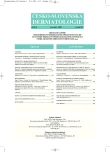-
Medical journals
- Career
Leg Ulcer and Thrombophilia
Authors: K. Poljaková 1; R. Pullmann 2
Authors‘ workplace: Kožná ambulancia Vrútky 1; Ústav klinickej biochémie, JLF UK Martin 2
Published in: Čes-slov Derm, 82, 2007, No. 6, p. 340-344
Category: Case Reports
Overview
The case report presents a patient with 10-year history of simultaneous chronic postthrombotic syndrome of the left leg with ulcerations and peripheral arterial atherosclerosis with haemodynamically important stenosis on both lower legs. Molecular genetic examination revealed mutation D/D in angiotensin converting enzyme (ACE); physiological genotype apolipoprotein E: apoE 3/2. Patient was heterozygous in three thrombophilic genes: prothrombin, methylenetetrahydrofolate reductase and plasminogen activator inhibitor I (PAI-I) which play important role in the pathogenesis of the disease. We might suppose that increased thrombophilic status determined by the presence of clinically important polymorphisms of three thrombofilic genes plays the decisive role in the pathogenesis of clinical picture. Supposedly the disruption of continual fibrinolysis due to interaction between genes ACE and PAI-I which were determined in pathological genotypes is the most important etiopathogenetically. The team-work of dermatologist, angiologist, cardiologist and haematologist with advanced laboratory diagnostics enables better etiopathogenetically based therapeutic approaches.
Key words:
inherited thrombophilic status – 5 genes: prothrombin, MTHFR (methyleneterahydrofolate reductase), PAI-I (plasminogen activator inhibitor I), ACE (angiotensin converting enzyme) and apo E (apolipoprotein E) – leg ulcer – peripheral arterial disease
Labels
Dermatology & STDs Paediatric dermatology & STDs
Article was published inCzech-Slovak Dermatology

2007 Issue 6-
All articles in this issue
- Dermatology in Transplantation Medicine
- Atopic Eczema and Environmental Factors Adversely Influencing its Cours
- Galenic Difficulties in Incorporation of Urea into Topical Semi-Solid Vehicles Used in Compounded Prescriptions
- Leg Ulcer and Thrombophilia
- Mammary Adenocarcinoma in Male and its Differential Diagnosis
- Czech-Slovak Dermatology
- Journal archive
- Current issue
- Online only
- About the journal
Most read in this issue- Galenic Difficulties in Incorporation of Urea into Topical Semi-Solid Vehicles Used in Compounded Prescriptions
- Atopic Eczema and Environmental Factors Adversely Influencing its Cours
- Dermatology in Transplantation Medicine
- Leg Ulcer and Thrombophilia
Login#ADS_BOTTOM_SCRIPTS#Forgotten passwordEnter the email address that you registered with. We will send you instructions on how to set a new password.
- Career

